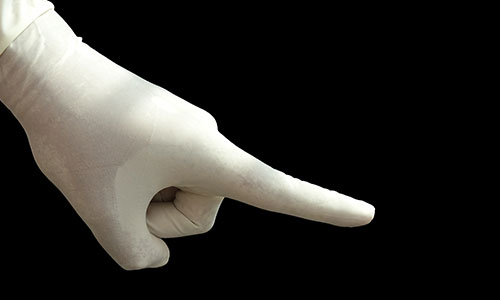The prostate exam | What to expect and why you should get checked
- Overview
As men, we often put off health checks, especially when they involve sensitive areas like the prostate. However, a simple prostate check can make all the difference in detecting potential issues early.
In this article, Consultant Urological Surgeon Gareth Brown walks you through what a professional is looking for, what to expect, and why it’s crucial to get checked if you're unsure about something.
How long does a prostate exam take?

There's no shying away from the fact that a prostate examination involves your clinician inserting a gloved and lubricated digit into the rectum.
While that may not sound pleasant, it doesn't take long. The whole appointment typically takes a few minutes and the part you're dreading should last less than 20 seconds.
How does the examination work?
You'll be granted some privacy to take off your lower clothing before being asked to lie on your side and draw your knees up to your chest. While it's natural to tense up in these situations, the clinician's lubricated finger should slip in without issue. Once it's in there it usually takes just a few seconds for the anal sphincter to relax around it.
You'll likely feel some pressing at this point. This shouldn't be painful but you may feel a brief urge to urinate. If you do experience any pain you should tell your examiner straight away. If the exam is physically intolerable for you but deemed necessary, it can be performed under general anaesthetic.
Once the surface of the prostate has been inspected, the finger is removed and the area around the anus cleaned of any residual lubricant.
What are we looking for?

Many men experience issues with their prostate gland as they age. The symptoms of benign prostate enlargement and prostate cancer are very similar, with most men presenting urinary issues first.
When your prostate has enlarged, the surface is typically smooth. We begin to suspect prostate cancer when the surface is hard and lumpy. It's a key difference and the best way to find out is via a rectal exam.
What will I know afterwards?
A rectal exam can't definitively diagnose prostate cancer. Only a biopsy can do that and you wont be offered one if you don't need it.
Rectal exams are part of a suite of diagnostic tests, including PSA blood tests and MRI scans, that help to either build or break the case for further investigation.
Can't I just get a blood test?
If you have concerns about prostate cancer, you definitely should have a Prostate Specific Antigen (PSA) blood test. Knowing your PSA level can help to establish what's normal for you so that a spike (which could indicate the presence of cancer) is more easily identified.
Unfortunately, a blood test alone isn't enough. The test has been known to deliver 'false-positive' results in some cases, leading men into have invasive biopsies for no reason. Up to 20% of men with prostate cancer show no increase in PSA levels*, so it's best used to check against the result of a rectal exam, but can't be relied upon in isolation.
What if we find something?

A rectal exam can give us an indication that cancer may be present but discovering a lump is not a cancer diagnosis. If the examiner finds the surface of your prostate to be hard and lumpy or your PSA levels are higher than expected you may be referred for additional tests. If you haven't already seen a Consultant Urologist they may conduct another rectal exam to check the GP's initial assessment.
The next step is usually to have an MRI scan so an image of your prostate can be examined. If necessary, you may then be referred for a biopsy to take a sample from your prostate. Even then, finding cancer cells in your prostate doesn't necessarily mean you'll need cancer treatment. Find out more on the truth about prostate cancer diagnosis here.
*Reference: NHS England
Last updated Tuesday 20 August 2024
First published on Monday 23 November 2015

